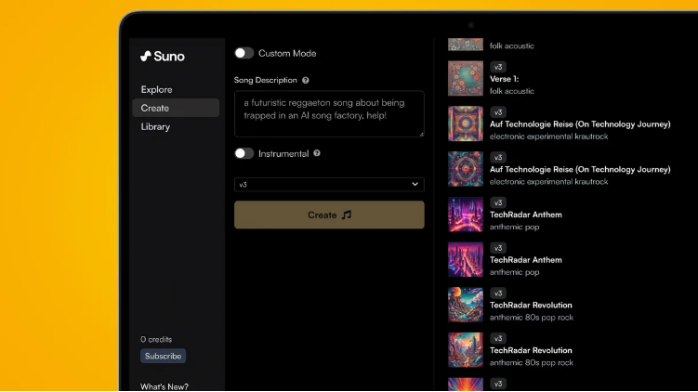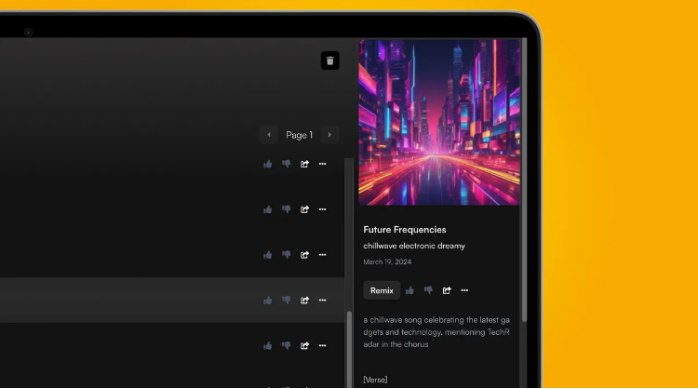Since ChatGPT made a splash in November 2022, we’ve seen generative AI create some surprisingly human-like art — and the latest tool to go viral is Suno, an AI-powered song generator.
We’ve seen AI beforeMusic Generator, from Adobe's Project Music GenAI to YouTube's Dream Track and Voicify AI (now Jammable). But what's different about Suno is that it can create everything from lyrics to vocal and instrumental arrangements based on simple prompts. You can even direct it to the exact genre you want, from Delta Blues to electronic coldwave.

In Suno's new V3 model, you can now create full two-minute songs with a free account. Results may vary depending on the genre you choose, but Suno is capable of producing some impressive results.
So, how exactly does Suno work? Who actually owns the music it generates? And how can you start making your own robot rock? We’ve answered all these questions so you can jump into the strange world of AI-generated music…
What is SUNO?
Suno is a web-based text-to-music generator that can create complete songs in seconds from simple text prompts. Tell it to make a "psychedelic UK garage-style song about a friend obsessed with Nokia," for example, and you'll get a two-minute song or two complete with vocals, instrumental arrangements, lyrics, song titles, and even artwork.
This is all possible with the free version of Suno, although naturally these accounts come with limitations. You get a maximum of 50 credits per day, enough to make ten songs. You also can’t use the songs commercially on a free account, so it’s great for dabbling or writing songs for your dog.

If you opt for the Pro plan ($8 per month, about £6.30 or AU$12.20) you'll get enough credits to generate 500 songs per day, which you can then use commercially, such as on YouTube or even upload to Spotify or Apple Music.
The Premier plan ($24 a month, about £20 or AU$38) raises your daily limit to 2,000 songs, which makes Bob Dylan look relatively lazy. But whichever plan you choose, you get access to all of Suno's tools - including a 'custom' mode where you can write your own lyrics, and an 'instrumental' mode for making some new music for work.
How does Suno work?
Like most generative AI tools, Suno’s workings are somewhat murky. It’s not clear what kind of data or music the tool was trained on — we reached out to Suno for clarification but have yet to hear back.
But more broadly, Suno works similarly to large language models (LLMs) like ChatGPT. Huge amounts of training data (in Suno's case, voice recordings) help it construct original songs and lyrics based on your prompts. For text, LLMs typically work by predicting the next most likely word to appear in a given sequence, but for music, it's a lot more complicated.

That’s why Suno also uses what’s called a diffusion model (similar to Midjourney) as well as a transformer model. In an interview with Lightspeed Venture Partners, Mikey Shulman, CEO and co-founder of Suno, said, “Not all audio is done with transformers, a lot of audio is done with diffusion — both approaches have their pros and cons.”
Whatever algorithmic changes are going on under the hood of Suno, it’s one of the best AI music generation engines we’ve seen (or heard) to date. Sure, the results are heavily compressed, and it’s stronger at mimicking some genres than others, but it’s also the perfect project to work on on a rainy weekend afternoon…
How to use Suno?
Suno is very simple to use – perhaps too simple, which might be worrying if you currently make a living in music. Simply visit the Suno website, create a free account, and go to the Create section to get started.
Here you'll find a small box for writing a description of your song. The main things to remember are to describe the style of music you want (in other words, the genre), and the topics you want the song to cover. You can't ask Suno to write a piece in the style of a specific artist - which is understandable, since Suno doesn't currently have any licensing agreements with record labels.
We asked Suno to write a TechRadar theme song celebrating electronics and technology in the genre of electronic coldwave - you can hear the resulting Future Frequency song below (or open it on Suno and you can read the lyrics).
Not bad for a first attempt. It's not going to win any Grammys because it has a generic EDM synth sound with echoes of The Weeknd, but it's also one of the few times Suno pronounces TechRadar's name correctly for the first time.
Challenging Suno with more simplified genres produced slightly mixed results. Our attempt to make a solo acoustic guitar song about a "sad AI that longs to be human" sounded like a robot Phoebe Bridgers forced to write a Eurovision ballad. Suno also had a hard time writing a birthday song for our friend in the style of psychedelic nineties rock.
But we also heard some surprisingly impressive blues music – for example, Rolling Stone managed to produce a delta blues track, “Soul of the Machine” (below), which has nearly 40,000 plays on Soundcloud and sounds an awful lot like a lo-fi recording from the Deep South.
Suno's latest V3 model launched on March 21, and one of its touted benefits is "more styles and genres," so its diversity should start to improve over time.
Suno's results can also be polished using other apps, such as Band in a Box, to help improve sound quality and instrumental arrangements. Simply go to the three dots in the song title, then to "Downloads," then to "Audio" to get the file. To extend a song, select "Continue from this segment," generate a new part, then select "Get full song" to stitch it all together.
Apparently, you can’t commercialize the results unless you’re on a paid plan, and you’ll also need to credit the song to Suno. Of course, this leads to a larger discussion about copyright and ownership…
Who owns the copyright to the songs composed by Suno?
The short answer is that you own the songs you generate through Suno as long as you choose Suno's Pro or Premier plans. If you are a free user, Suno says it will retain ownership of the songs you generate.
But this is not the same as copyright ownership. As Suno’s FAQ section states: “The availability and scope of copyright protection for content generated (in whole or in part) using AI is a complex and dynamic area of law that is evolving rapidly and differs between countries.”
For example, in the United States, creations generated by AI without human involvement cannot currently be protected by copyright. Text-to-music tools like Suno make the situation even more complicated, which is why Suno recommends consulting a lawyer if you really need up-to-date legal guidance on how to handle your AI-generated masterpiece.

At the moment, a wider debate around AI-generated content is looming in the background. For example, the New York Times is suing OpenAI and Microsoft because it claims ChatGPT was trained on millions of its articles without its permission. Does training an AI model on someone else’s content infringe copyright? This is an important question that has yet to be answered.
You may remember the May 2023 viral hit “Something to Remember,” purportedly produced by Drake and The Weeknd, which amassed nine million views on TikTok until it was later revealed to have been produced by a user named Ghostwriter977 using artificial intelligence. The artist’s record company, Universal Music Group, subsequently issued a takedown notice, sparking a copyright dispute that is still ongoing.
That’s why Suno legitimately doesn’t allow you to ask it to generate songs in the style of a specific artist or use the voices of real artists. According to Rolling Stone, Suno’s backers are aware that music labels and publishers might one day sue them, but the labels are keeping mum on the matter for now. In other words, this is an area worth watching right now (and wearing a pair of big noise-canceling headphones if you’re Suno).
What does the future hold for Suno?
A glimpse of Suno's possible future development can be seen in Google's Dream Track project, which has partnered with artists to allow a small number of early users to generate AI tracks for their YouTube Shorts.
If Suno can get the support of a music label, it could create a new AI-generated track in the style of your favorite artist. As Suno CEO Mikey Shulman told Lightspeed Venture Partners, “Fast forward a few years, when the licensing situation is less uncertain, maybe we can let you cue the model with a Taylor Swift song.”
The idea is to let you pay artists just like you do with sampling today, except you’ll use their music as a template for new AI-generated tracks.
However, it’s still early days, and with licensing issues yet to be resolved, Suno is currently more of a fun way to create an original birthday song for a friend than a fully fledged robot musician.
Meanwhile, Suno faces competition from rivals like Google, Adobe, and OpenAI. However, for now, Suno is one of the best tools we’ve tried for producing full songs, and with V4 coming soon, we’re looking forward to seeing it evolve further.